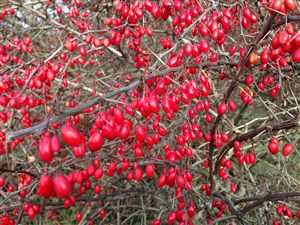Barberry (Berberis vulgaris)
Main Facts about Barberry

Using Barberry
The root, bark, and berries are used for medicinal purposes. Berry tea is diuretic, laxative and expectorant. Root bark tea is antiseptic blood cleanser used to clean liver for jaundice, hepatitis, bile production. Barberry possesses febrifuge powers and is used as a remedy for intermittent fevers. It also forms an excellent gargle for a sore mouth. A good lotion for application to cutaneous eruptions has also been made from it.Barberry is a remedy for: Cold and flu, Anxiety, Arthritis, Constipation, Weight loss
Caution!
Because it contains so many strong compounds, don’t overdo it. Do not use during pregnancy.Cooking with Barberry
The berries are edible and rich in vitamin C, though with a very sharp flavor. Have been traditionally used as an ingredient in making jam. In Iran, barberries are commonly used in rice pilaf. Except for its fruits and seeds, the plant is mildly poisonous.How to grow Barberry
Habitat: dry, sunny hillocks and forest margins. Flowering time in North America and western Europe: May or June and fruits are generally ripe by August or September. Seeds may mature by October. Berries are persistent and remain on stems through winter. Barberry reproduces by seed and from rhizomes that are detached from the parent plant. The best time for laying down the branches is in autumn (October), and the young shoots of the same year are the best- these will be well rooted by the next autumn, when they may be taken off and planted where they are designed to remain.| Avocado |
Barley grass
|